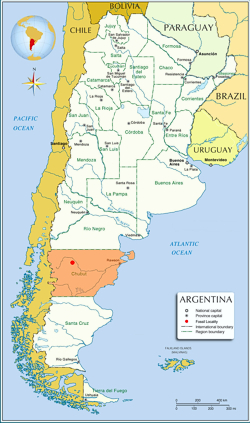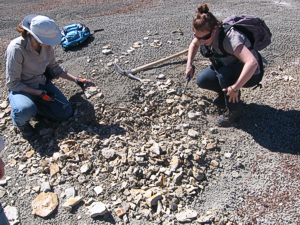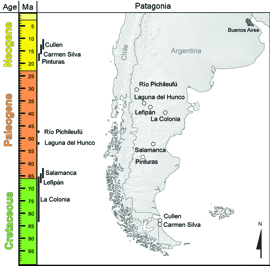
The La Colonia Formation biota comes from several fossil localities preserved in the middle part of the La Colonia Formation of north-central Chubut Province, Argentina. The fossil-bearing part of the formation is thought to belong to the Campanian to Maastrichtian ages of the Late Cretaceous period, making the fossils about 65.5 to 83.5 million years old. The sediments have been interpreted as possibly representing a lagoon or lake environment. The climate at the time the La Colonia Formation was deposited was warm, with distinct wet and dry seasons.
The La Colonia Formation is perhaps best known for its interesting vertebrate fauna, which includes fish, terrestrial reptiles (lizards, snakes), aquatic and marine reptiles (turtles, plesiosaurs), birds, and mammals. One of the most interesting animals found in the formation is the carnivorous dinosaur Carnotaurus sastrei, which had a horned skull. The flora of the La Colonia Formation is not very diverse. Plants, some aquatic, are known from four separate localities: Cañadón del Irupé , Cerro Bosta, Cerro Buitre, and Quebrada del Helecho.
Gandolfo Lab Research
Study of the flora of the La Colonia Formation is a collaborative effort between researchers at several institutions, including the Gandolfo lab at Cornell University (Ithaca, New York) and the Museo Paleontológico Egidio Feruglio (Trelew, Chubut Province, Argentina). The primary goal of this project is to document the diversity of the flora.
Field Work

In 2010, Dr. María A. Gandolfo and Dr. Elizabeth J. Hermsen did field work in the La Colonia Formation with a team from the Museo Paleontológico Egidio Feruglio, and Dr. Ari Iglesias from the Museo de La Plata (La Plata, Argentina). The primary purpose of this trip was to collect data on the stratigraphy of the La Colonia Formation, although some fossil plant specimens were also collected.
Lab Work
Much of the detailed work involved in describing and understanding species of fossil plants takes place in the lab. We employ many traditional methods of paleobotanical study, such as making observations, describing fossil species, and comparing fossil species to living plants, in order to understand the plants that we find in the field. In addition, we use modern analytical techniques to attempt to gain a more precise understanding of the evolutionary relationships of fossil and living plants.
Other Paleofloras
(Youngest-Oldest)
- Cenozoic Paleofloras
- Cullen (middle Miocene)
- Carmen Silva (Miocene)
- Pinturas (late-early Miocene)
- Río Pichileufú (early-middle Eocene)
- Laguna del Hunco (Early Eocene)
- Salamanca (early Paleocene)
- Cretaceous Paleofloras
- Lefipán (Maastrichtian- 65.5-66 myo)
- La Colonia (Campanian to Maastrichtian)
